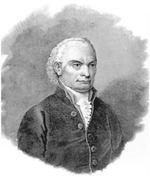Nationality Italian Name Domenico Cotugno | Role Physician Fields Physician | |
 | ||
Education University of Naples Federico II | ||
SPS Italia 2015 - Intervista a Domenico Cotugno, Pepperl + Fuchs FA Italia (Class CNBC)
Domenico Felice Antonio Cotugno (January 29, 1736 – October 6, 1822) was an Italian physician.
Contents
- SPS Italia 2015 Intervista a Domenico Cotugno Pepperl Fuchs FA Italia Class CNBC
- Biography
- Associated eponyms
- References

Biography
Born at Ruvo di Puglia (Province of Bari, Apulia) into a family of humble means, Cotugno underwent physical and economic hardships to get an education. He was sent to nearby Molfetta for training in Latin, returning to Ruvo for work in logic, metaphysics, mathematics, physics, and the natural sciences. He soon found his natural bent in medicine and continued his studies from 1753 at the University of Naples, and in 1756 graduated from Salerno medical school. He received his doctorate in philosophy and physics in 1755, and became an assistant at the Ospedale degli Incurabili (Neapolitan Hospital for Incurables). In 1761 he became professor of surgery at that hospital, and was subsequently for 30 years professor of anatomy at the high school of Naples. In 1808 he was appointed royal physician to the King of Naples. He ceased lecturing in 1814, suffered a cerebral embolism in 1818 that recurred in 1822, resulting in his death.
In 1765 he made trips to Rome and northern Italy to visit libraries and men of science, including Giovanni Battista Morgagni (1682–1771), and in 1789 he travelled to Austria and Germany as physician to Ferdinand IV, king of Naples. An outstanding example of the physician–humanist, Cotugno was devoted to books and accumulated a large library, was well versed in art, architecture, numismatics, and antiquities, and had a great facility in the Latin language.
In 1761 Cotugno published for distribution to friends a plate that traced the course of the nasopalatine nerve, which is responsible for sneezing. Antonio Scarpa acknowledged his priority in knowledge of this nerve. In the same year his anatomical dissertation De aquaeductibus auris humane internae, following the work of Guichard Joseph Duverney and Antonio Maria Valsalva and anticipating that of Hermann von Helmholtz, described the vestibule, semicircular canals, and cochlea of the osseus labyrinth of the internal ear, demonstrated the existence of the labyrinthine fluid, and formulated a theory of resonance and hearing.
Cotugno wrote a classic monograph on sciatic neuralgia, and is also credited the discovery of the cerebrospinal fluid in 1774. He investigated smallpox, was deeply concerned with controlling pulmonary tuberculosis, and exemplified to many students the true investigative and selfless spirit in anatomy and medicine. He was the teacher of the future military doctor Antonio Savaresi. The Ospedale Domenico Cotugno, hospital in Napoli is named for him.
